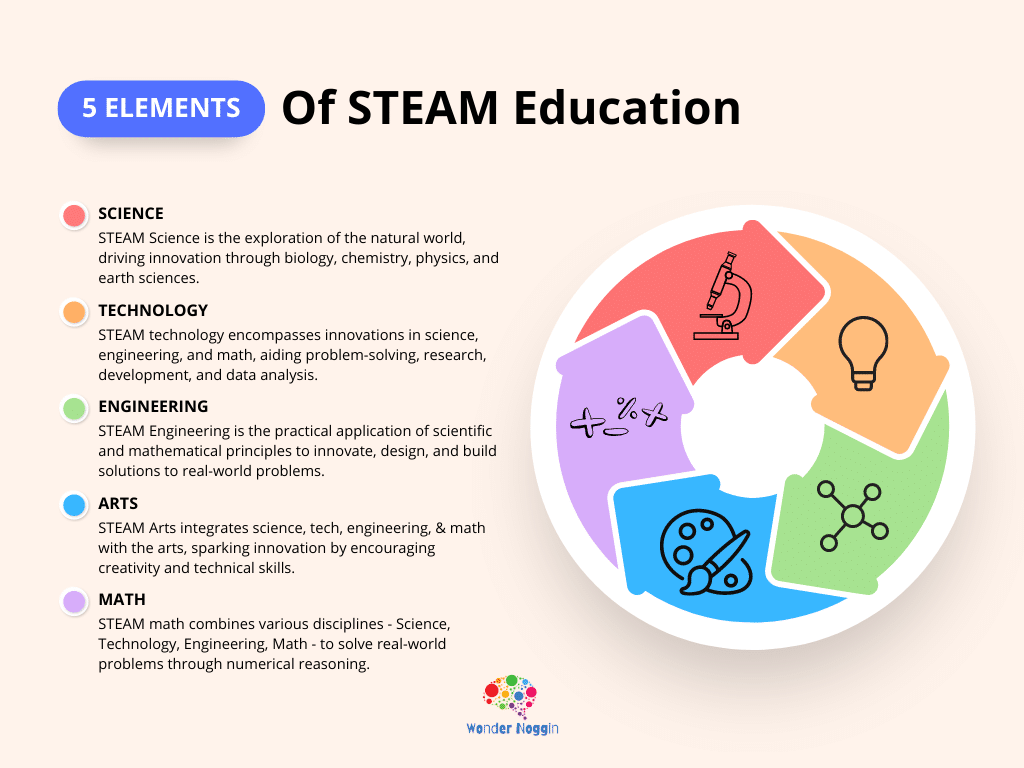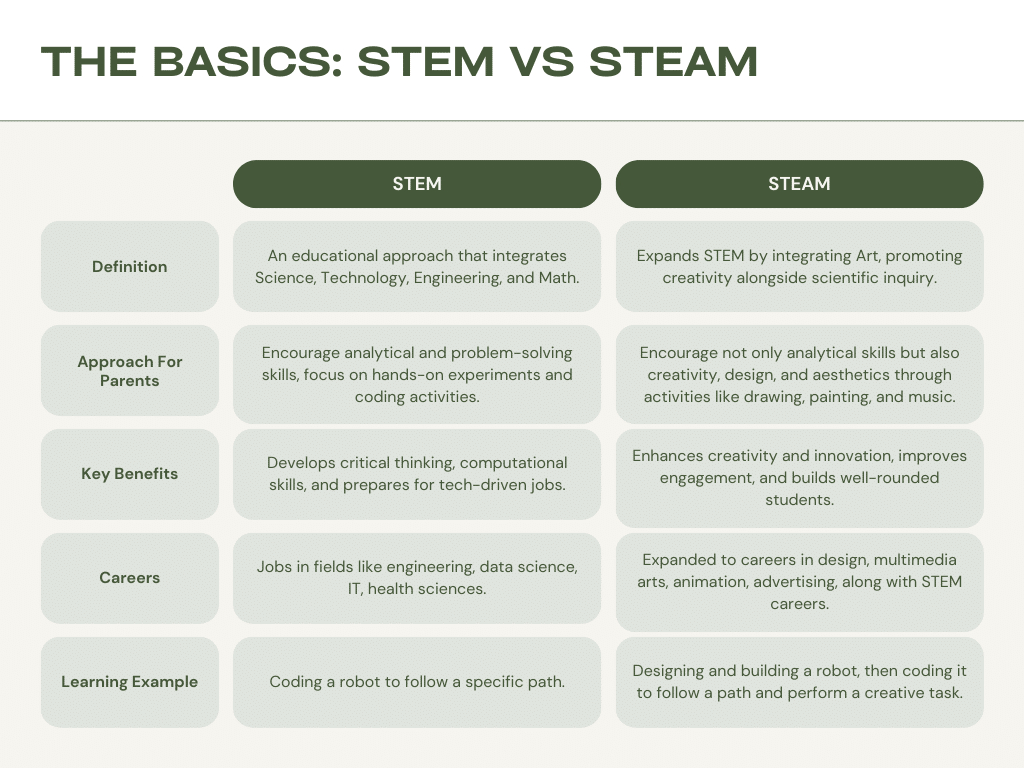As a parent, you might be wondering, “What’s this STEAM thing I keep hearing about?”
Well, STEAM stands for Science, Technology, Engineering, Arts, and Mathematics.
It’s an integrated approach to learning that connects these five disciplines into a unified whole.
The ‘A’ for Arts is the special ingredient—it adds a dash of creativity and design principles thinking to the mix.
Teaching STEAM at home is a great way to help your little ones get a “leg up” as they begin their education journey. By studying these fields as a connected unit, kids don’t just memorize facts—they learn how to apply knowledge in real-world situations.
STEAM is all about fostering critical thinking, problem-solving, innovation, and creativity in our young learners.
What Is STEAM Education?
STEAM education is a comprehensive and integrated approach to learning that stands for Science, Technology, Engineering, Arts, and Mathematics.
Understanding the acronym and the importance of STEM stands is important for educators and students alike, as it emphasizes the importance of interdisciplinary learning and the integration of various subjects.

Rather than teaching these subjects in isolation, STEAM activities weave them into a cohesive curriculum that promotes cross-disciplinary learning. It’s not just about memorizing facts or formulas but about understanding real-world concepts and applying knowledge in innovative ways.
STEAM offers hands-on learning experiences to children to help them build a foundation for real-life applications of knowledge.
As we discussed before, STEAM covers science, technology, engineering, art, and math, and here is a brief breakdown of what each of these pillars covers in STEM projects within STEAM learning, including steam lessons.
- Science: This forms the basis of understanding the natural world around us. It covers everything from biology and chemistry to physics and environmental science, and you can teach these concepts with some great STEAM science activities. In STEAM, children learn to ask questions, explore, and experiment, fostering their curiosity and love for learning.
- Technology: In today’s digital age, being tech-savvy is crucial. This aspect of STEAM education involves using engaging STEAM technology activities, learning about computer programming, computer science, and how technology can be used to solve problems. It’s about more than just using technology—it’s about understanding it and using it creatively.
- Engineering: This field is all about designing and building solutions. There are plenty of great STEAM engineering projects available, from constructing bridges to programming robots. Children learn to apply scientific and mathematical concepts to real-world challenges. It encourages them to think critically and innovate, turning ideas into reality.
- Arts: Often overlooked in traditional STEM education, the STEAM arts activities add a vital component to STEAM—creativity. It encompasses everything from visual arts and music to drama, encouraging children to express themselves, communicate effectively, and think outside the box.
- Mathematics: It’s more than just numbers and equations; mathematics teaches logical thinking and problem-solving skills. In STEAM, kids learn to use math to describe and analyze the world, making connections between abstract theories and real-world applications with fun STEAM math projects.
STEAM cultivates essential skills such as critical thinking, problem-solving, creativity, and innovation. By fostering these abilities, STEAM prepares your children for future careers in thriving fields like engineering, technology, and design.
STEAM education doesn’t only help your children adapt to the fast-paced changes of the 21st century, but it empowers them to become the changemakers of tomorrow, inspiring them to think outside the box, solve complex problems, and create a better future through the integration of arts and the STEAM movement.
Why Is STEAM Education Important?
The importance of STEAM education and its educational approach for your children’s development cannot be overstated. By integrating science, technology, engineering, arts, and mathematics, STEAM education presents a holistic approach to learning.
It goes beyond mere knowledge acquisition because it nurtures critical thinking, problem-solving abilities, and creative thinking, including the first step of problem-solving. This interdisciplinary approach to learning equips your little ones with essential tools to thrive in an ever-evolving world.
STEAM education is pivotal as it prepares STEM students for future careers that necessitate a multidisciplinary approach, many of which might not even exist today.
As technology progresses, skills such as coding with kids coding languages, data analysis, and design thinking are increasingly in demand in the modern workforce, particularly in STEM careers.
STEAM education, which includes STEAM subjects, is a step towards building those competencies, ensuring that your children are equipped to keep pace with the changing world and ready to lead it. In essence, STEAM education is not just about making a living; it’s about making a difference for future generations.
What Is The Difference Between STEM vs STEAM?
As a mom, I know how important it is to give our children the best education possible.
You might have heard about STEM program, which stands for Science, Technology, Engineering, and Mathematics. Well, STEAM is a step up from that, adding an ‘A’ for Arts integration.

STEAM education goes beyond traditional STEM subjects by integrating arts and design into the learning process. This holistic approach offers numerous advantages for children’s development and creativity, making it an appealing option for parents who want to teach their kids STEAM. Here are the benefits that STEAM offers over traditional STEM education:
- Enhanced Creativity: By incorporating arts into STEM subjects, STEAM encourages creative thinking and expression. It allows children to explore innovative solutions and think outside the box, fostering their imagination and originality.
- Holistic Learning: STEAM projects often involve a multidisciplinary approach, providing a broader understanding of real-world challenges. Children can connect concepts from different fields, promoting a holistic and interconnected view of knowledge.
- Engaging and Fun: Integrating arts and hands-on activities make learning enjoyable for kids. It creates a more interactive and engaging learning environment, increasing their motivation and interest in STEAM subjects.
- Cultivating Critical Skills: STEAM education nurtures critical skills such as problem-solving, communication, collaboration, and adaptability. These skills are essential for future success in both STEAM-related careers and various other fields.
- Real-World Applications: STEAM encourages practical applications of knowledge. Children can explore how science, technology, engineering, and math intersect with arts to solve real-world problems, making their learning relevant and meaningful.
The beauty of STEAM is that it embraces the creative elements often overlooked in traditional STEM education. While STEM will include activities like coding robots for kids, science toys for kids, and engineering puzzles, STEAM introduces art projects like string art kits to teach children how to think creatively along the way.
Incorporating arts into STEM education enriches the learning experience and empowers children to become well-rounded, creative thinkers with a strong foundation in STEAM subjects. As parents, embracing STEAM education can provide your kids with valuable skills and prepare them for a future where innovation and creativity are highly prized.
Why Add Arts To STEM?
Have you ever noticed how creativity often ignites when we incorporate the arts into learning? That’s exactly the rationale behind adding the ‘A’ for Arts into STEM, transforming it into STEAM. By integrating arts into STEM education, we give our children an invaluable skill: the ability to think creatively and innovate.
Just consider this—great inventions don’t just spring from technical know-how; they also require a spark of creativity and innovative problem-solving. This is where the arts can play a significant role. It’s a platform that encourages freedom of expression, enhances critical thinking skills, and boosts communication skills—making learning more engaging and fun!
In our fast-evolving world, the future will not just be shaped by engineers and scientists but also by artists and designers who can think outside the box. Through STEAM education, we’re setting our kids up for a future where they can apply their creative skills to impact industries and society positively. It’s not just learning—it’s empowering them to create change.
View this post on Instagram
Tips To Teach STEAM To Your Kids
Teaching kids STEAM at home can be a rewarding and enjoyable experience, but keeping them engaged throughout the learning process is crucial for successful outcomes. Here are some effective tips to ensure your kids stay enthusiastic and motivated while exploring the wonders of STEAM:
- Hands-On Experiments: Engage your kids in interactive, hands-on experiments and projects. Let them explore scientific principles through simple experiments or build engineering structures using household materials. This tactile approach fosters curiosity and sparks their interest in STEAM concepts.
- Integrate Arts and Creativity: Incorporate arts and creativity into STEAM activities. Encourage your kids to draw, paint, or craft models related to the scientific or engineering concepts they are learning. This combination allows them to express themselves creatively while reinforcing STEAM knowledge.
- Real-World Relevance: Show your kids how STEAM is relevant in the real world. Discuss how scientific discoveries of how STEM is used in everyday life, or explore how technology and engineering have revolutionized various industries. Understanding the practical applications of STEAM subjects makes learning more meaningful.
- Field Trips and Guest Speakers: Organize virtual or in-person field trips to science museums, engineering workshops, or art galleries. Invite guest speakers, such as scientists, engineers, or artists, to share their experiences and insights. Exposure to real professionals in STEAM fields inspires and motivates kids to pursue their interests.
- Gamified Learning: Introduce educational STEAM games and apps that make learning enjoyable. Many interactive platforms offer fun challenges and puzzles that teach coding, math, or problem-solving skills. Gamified learning provides a balance of education and entertainment.
By implementing these tips, you can create a stimulating and engaging STEAM learning environment at home. Embrace your child’s curiosity, encourage exploration, and let them take the lead in their STEAM journey. Remember that the process should be enjoyable, allowing kids to develop a lifelong passion for learning in these exciting disciplines.
What Is The Future Of STEAM?
Looking at the world today, it’s clear that the future of STEAM is not just bright—it’s dazzling! As technology advances at a breathtaking pace, there’s going to be a surge in demand for professionals equipped with STEAM skills.
Our children are growing up in a world where careers in robotics, artificial intelligence, and other innovative fields are not just possibilities—they’re realities.
STEAM education will be the guiding light in preparing our children for these future jobs.
By integrating arts and creativity into STEM fields, we’re not just giving them a strong academic foundation.
We’re equipping them with the ability to innovate, solve complex problems, and think outside the box—skills that are going to be invaluable in the workforce of tomorrow.
So, let’s introduce our children to STEAM and give them the best possible preparation for their future. We’re not just teaching them—we’re empowering them to be the pioneers of tomorrow’s world.







0 Comments